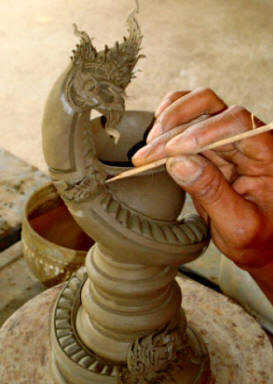Home › Diving › Thailand › Central › Bangkok › Attractions › Koh Kret Pottery
Pottery and Earthenware Ko Kret Island
Pottery on Ko Kret Island is world famous for its intricacy of hand finishing before the kiln fires it to a rich orange brown unglazed finish.
Ko Kret Island is probably known for it's earthenware pottery more than anything else. Little wonder, because the craftsmanship that goes into moulding a simple piece of local clay into a beautifully made piece of pottery requires time and skill.
The Potters on Ko Kret Island, Bangkok
It would be easy to stay for hours just watching the skill and mastery of the pottery carvers on this small island.
The normal carving tool is the same 'skewer' with which most of the roadside foods are served.
Nothing more, but it is the steady hand and focussed eye of the Ko Kret Pottery worker that is important.
Centuries of handed-down skills of the Mon families have ensured that the Ko Kret pottery is here to stay, and quite unique in its quality and appearance. Ko Kret Pottery is a part of the OTOP system in Thailand.
The hand carving of the pottery is what sets it aside from other terracotta pots throughout the world.
The eastern influence of the Mon tribes - originally from China can soon be seen both in the artistry and also the subject matter.
The Mons did not choose to be here in Thailand. Like so many other Eastern peoples, they were forced by circumstance.
 In this case the 'migration' was helped along by early Burmese races, who also moved along with them to settle firstly in northern Thailand, and also to the Chao Phraya River area in Central Thailand.
In this case the 'migration' was helped along by early Burmese races, who also moved along with them to settle firstly in northern Thailand, and also to the Chao Phraya River area in Central Thailand.
The pottery on Ko Kret is hand thrown - that is to say that it is not forced into moulds of any kind.
The potter's wheel is normally a pedal operated basic contraption upon which the raw clay is placed (thrown) and then moulded in time honoured fashion by the cupping and shaping of hands.
Once the basic shape has been attained, the item of pottery is removed and normally placed in a drying shed so that it does not dry out too quickly - otherwise it will crack - and at a point between this and the kiln, is taken to be hand carved - with a skewer.
There are several types of kiln on the island of Ko Kret in Bangkok - Scorpion, and Chinese to mention two.
The pots are lightly dried before consigning to the kilns where they are baked to the normal terracotta colour that is the trademark of unglazed pots the world over.
The local clay - whilst being mid to dark brown upon excavation - semi-dries to a light tan, before the final firing.